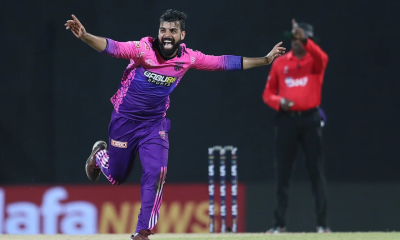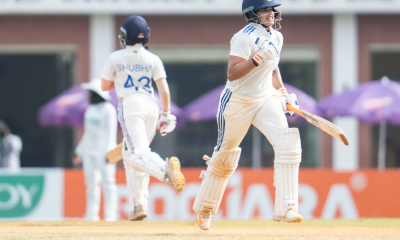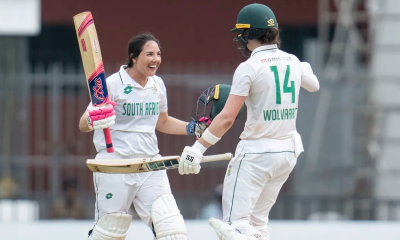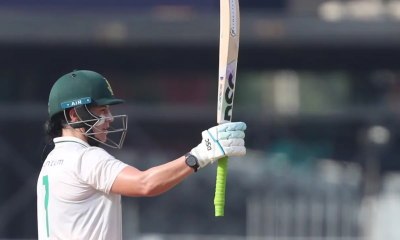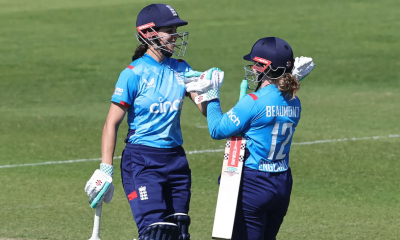Sports
How the ICC T20 World Cups have been won
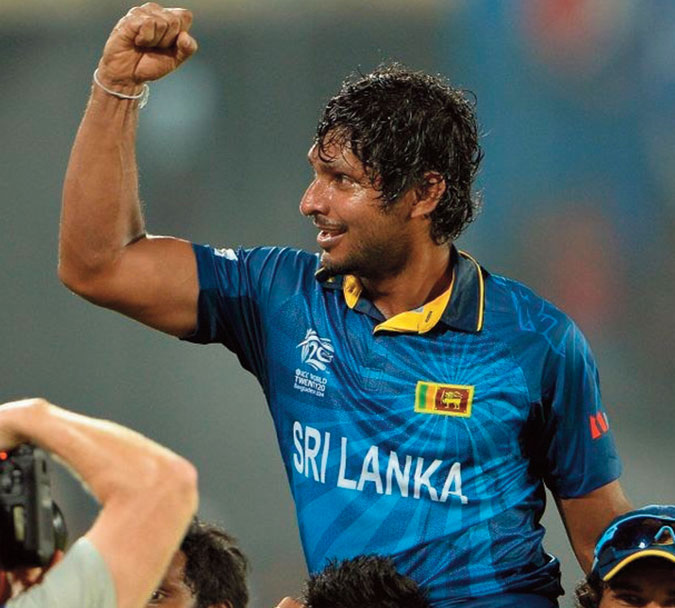
Memory Lane
The ICC T-20 World Cup gets underway in Australia next week when Sri Lanka take on Namibia at Geelong. The former champions and Namibia are grouped alongside UAE and Netherlands while Group ‘B’ comprises another former champion West Indies, Scotland, Ireland and Zimbabwe. Two teams from each group progress to the Super 12 stage. Here we take a look at how the previous seven editions have been won since the ICC launched the T-20 World Cup in South Africa in 2007.
2007 – India become inaugural winners
The first ICC T20 World Cup may have only lasted 13 days but there was no shortage of unforgettable moments. The opening fixture set the tone, Chris Gayle smashing ten sixes at the Wanderers to become the first player to make a T20I hundred. But that still was not enough for victory, with the Herschelle Gibbs-inspired hosts chasing down 205 with 14 balls to spare.
In a high-scoring tournament, Yuvraj Singh claimed headlines when he struck six sixes in an over, with England’s Stuart Broad on the receiving end. Yuvraj’s India had already made history when they beat Pakistan via a bowl-out in the group stage and when the fierce rivals met again in the final, the outcome was the same – though no less dramatic.Joginder Sharma was the man of the moment, holding his nerve with the ball when Pakistan required just six runs off four balls to steer his side to a five-run victory.
2009 – Afridi special lights up Lord’s
From agony to ecstasy, Pakistan became champions after beating Sri Lanka at Lord’s thanks to a Player of the Match performance from Shahid Afridi.The star of the show in the semi-final with a 34-ball 50 and figures of two for 16, Afridi top-scored again at the home of cricket, his unbeaten 54 guiding Pakistan to an eight-wicket win. Lord’s was a sea of green that afternoon but it had earlier turned orange for one of the tournament’s greatest shocks.Netherlands chased down 162 to beat England in the last ball of the tournament’s opening fixture.
Arguably the best individual display of the tournament came at The Oval, where Umar Gul’s five-for, the first in T20Is, saw Pakistan pip the Black Caps to a semi-final spot and they later returned to the capital for a first major tournament win in 17 years.
2010 – England down Australia
Paul Collingwood’s England turned around a disappointing start to their campaign in remarkable fashion before securing the trophy in Bridgetown. They opened up with an eight-wicket loss against the hosts and were restricted to 120 batting first against Ireland.
Rain intervened, which saw England progress on net run rate at Ireland’s expense, and they then clicked into gear and advanced into the final where they met old rivals Australia.Fittingly, it was Collingwood who hit the winning run with three overs to spare while Kevin Pietersen, who scored 47 in the final, was named Player of the Tournament.
2012 – West Indies upset Sri Lanka’s party
A match-winning 78 from Marlon Samuels carried West Indies to their first ICC T20 World Cup crown in Colombo.The team’s path to the final was eerily similar to that taken by England two years earlier. After losing their opener to Australia, a clash with Ireland was washed out leaving the Windies second in the group on net run rate.
They were soundly beaten by Sri Lanka in the Super 8 stage but a Super Over win over New Zealand secured progression to the last four.Then came revenge against the hosts in the final, Samuels shining with the bat and Sunil Narine claiming three for nine as the Windies strolled to a 36-run victory.
2014 – Sangakkara seals Sri Lankan success
Spurred on by the disappointment of missing out on home soil, Sri Lanka went one better in Bangladesh two years later.The Lions topped Group 1, dismissing the Netherlands for 39 and New Zealand for 60 as their bowling attack proved irresistible.
The semi-final, a repeat of the final two years earlier, saw Sri Lanka defeat West Indies to set up a clash with India which saw two icons bow out in style in their last ever T20Is.Mahela Jayawardene became the first batter to reach 1000 ICC T20 World Cup runs before Kumar Sangakkara saw his side home with an unbeaten half-century, ensuring 77 from the tournament’s leading run-scorer Virat Kohli turned out to be in vain.
2016 – Brathwaite blitz secures dramatic triumph
Carlos Brathwaite, remember the name. Ian Bishop’s iconic commentary provided the backdrop to a stunning performance by the Bajan, whose four successive sixes from the last over of the final led West Indies to their second ICC Men’s T20 World Cup crown.West Indies needed 19 from the final six balls against England and Brathwaite – who had earlier taken three wickets with the ball – made light work of the challenge, Ben Stokes the unfortunate bowler.
Samuels again proved himself a man for the big occasion, named Player of the Match for his unbeaten 85, while several Windies batters stepped up at various times across the tournament.Gayle blasted a 47-ball century in the group stage clash with England, Andre Fletcher’s unbeaten 84 inspired a seven-wicket win over reigning champions Sri Lanka and Lendl Simmons smashed 82 not out from 51 balls in the semi-final victory over India.
2021 – Australia off the mark in style
No country has enjoyed more ICC Cricket World Cup success than Australia but they arrived in the UAE still waiting to make their mark in the shortest format.Having progressed through the group stage, however, Aaron Finch’s side saved their best for the knockouts and dumped out Pakistan, who came into the semi-finals unbeaten, in the last four.
The final pitted Australia against neighbours New Zealand, for whom Kane Williamson’s 85 was the standout innings in a total of 172 for four. It did not prove enough against an in-form batting line-up, Mitchell Marsh’s unbeaten 77 from 50 balls guiding Australia to an eight-wicket success which sees them head into this year’s tournament eyeing an unprecedented title defence.
Sports
St. Benedict’s, Devapathiraja record victories

St. Benedict’s registered innings and two runs win over Sri Dharmaloka College Kelaniya as Mevan Dissanayake excelled with impressive all round performances for the home team in the Under 19 Division I Tier ‘B’ Cricket encounter at Kotahena.
It was a baptism of fire for the team from Kelaniya as they faced a well established school in the Tier ‘B’ two-day tournament for the first time after being promoted to the top Division of the premier schools cricket tournament.
They faced St. Joseph Vaz’s College earlier but their opponents were making their return to the top division. They managed to draw the first encounter.
At Kotahena they were dismissed for 188 and 105. Dissanayake bagged eight wickets including a five wicket haul in the second innngs to follow up his knock of 91 which set the stage for victory.
Meanwhile in another Tier B encounter Devapathiraja bounced back to pull off one wicket victory over St. Anthony’s Wattala.
The boys from Wattala did well to restrict Devapathiraja to 95 runs and take a lead of 29 runs. But Pijith Wathsuka, Gimhan Rasanjana, Sandaru Malshan and Yasiru Lakshan teamed up well to pull off a stunning win
Bens in innings win at Kotahena
Scores
St. Benedict’s 295 for 9 decl. in 56.4 overs (Mevan Dissanayake 91, Vihanga Rathnayake 42, Yohan Edirisinghe 31, Ayesh Gajanayake 49; Sathindu Praboda 4/98, Tharusha Mihiranga 2/66)
Sri Dharmaloka
188 all out in 56.3 overs (Senuka Pehesara 53, Kaveen Deneth 79; Ayesh Gajanayake 2/31, Mewan Dissanayake 3/55, Vihanga Rathnayke 4/19) and 105 all out in 35.4 overs (Vipun Sasanka 21, Tharush Mihiranga 32; Mewan Dissanayake 5/29, Vihanga Rathnayake 2/36, Lithika Jayasundara 3/34)
Devapathiraja in exciting one wicket win at Wattala
Scores
St. Anthony’s 124 all out in 30.4 overs (Shehara Dewthilina 51, Sandil Chathuranga 21, Rima Bashika 21n.o.; Sandaru Malshan 2/23, Puljith Wathsuka 4/19, Gimhan Rasanjana 3/13) and 100 all out in 43 overs (Hithesh Ruwanda 42n.o., ; Sandaru Malshan 5/40, Gimhan Rasanjana 2/37)
Devapathiraja
95 all out in 33.2 overs (Gimhan Rasanjana 24n.o., Ridma Bashika2/36, Vishmitha Saroj 2/22, Kavindu Senadi 4/33) and 131 for 9 in 26.3 overs (Yasiru Lakshan 26, Pulgith Wathsuka 28, Gimhan Rasanjana 42; Rima Bashika 2/18, Kavindu Senadi 4/48, Wishmitha Saroj 2/43)
by Reemus Fernando ✍️
Latest News
Rodrigues fifty leads India’s chase after bowlers set up victory against Sri Lanka

There was a little bit of rustiness as India returned to action 50 days after becoming ODI world champions, but not so much to prevent them from registering a dominant win in the first T20I against Sri Lanka in Visakhapatnam.
Despite dew being a constant presence on a cool evening, India’s spinners rallied to keep Sri Lanka’s top order in check – even if they did not pick up wickets in a heap – thus restricting them to 121 for 6. It was a below-par total given that the dew was only going to increase as the temperatures reduced – something Harmanpreet Kaur had alluded to while choosing to chase at the toss. India made easy work of it to get home with eight wickets and 32 balls to spare, starting their road to the T20 World Cup 2026 in June on the right note.
Jemimah Rodrigues, batting for the 100th time in T20Is, struck a 14th half-century in the format to help the hosts canter. There was a mild intrigue around India’s No. 3, with Harleen Deol batting at that spot for two games in England, and Harmanpreet signaling her intent to be India’s one drop at the last T20 World Cup. But Rodrigues’ 69 not out from 44 balls should dispel any doubts India would have had.
This was India’s sixth win in ten games since being knocked out in the league stage of the 2024 iteration.
Brief scores:
India Women 122 for 2 in 14.4 overs (Jemimah Rodrigues 69*, Smriti Mandhana 25, Harmanpreet Kaur 15*; Kawya Kavindi 1-20, Inoka Ranaweera 1-17) beat Sri Lanka Women 121 for 6 in 20 overs (Vishmi Gunaratne 39, Chamari Athapaththu 15, Hasini Perera 20, Harshita Samarawickrama 21; Deepti Sharma 1-20, Kranti Gaud 1-23, Shree Charani 1-30) by eight wickets
[Cricinfo]
Latest News
Sameer Minhas 172 powers Pakistan to Under-19 Asia Cup title

Opener Sameer Minhas blitzed his way to 172 off 113 balls, setting up Pakistan’s demolition of India in thDeepeshe Under-19 Asia Cup final in Dubai. In response to Pakistan’s 347 for 8, India folded for 156 in 26.2 overs.
Minhas’ knock was the highest individual score for Pakistan, and also, the highest individual score by any batter in a final in Youth ODIs. He hit 17 fours and nine sixes during his stay, and fell in the 43rd over, finishing with a strike rate of 152.21.
In response, Vaibhav Suriyawvanshi – having scored 5, 50, 9 and 26 in tournament since his 171 against UAE – made an explosive start to India’s chase. He smashed three sixes and a four, but Ali Raza had him nicking off for 26 off 10 balls. India had reached their fifty in the fifth over and by the end of the powerplay, they were 68 for 5.
Pakistan came into the final having bowled out each of their opposing batting line-ups in the tournament. This contest was no different – four Pakistan bowlers shared wickets among them, with Raza prising out three more wickets to finish with match figures of 4 for 42.
India were reduced to 120 for 9, but Deepesh Devendran offered some late resistance with 36 off 16 balls, including six fours and two sixes. No other India batter passed 30 in the chase. India’s innings ended when Raza had Devendran holing out in the 27th over.
Earlier in the day, Devendran had copped punishment from the Pakistan batters, conceding 83 runs in his ten overs though he took three wickets at the death.
Minhas was well-supported by Ahmed Hussain – the only other batter to cross fifty in the innings. Hussain made 56 off 72 balls and added 137 for the third wicket along with Minhas.
Pakistan faced a slight slowdown in the death overs, especially once Minhas was dismissed – they only managed 71 runs in the final ten for the loss of five wickets. Devendran took three of those wickets, but his death bowling was a footnote by the time he swung for the hills in India’s chase, and was eventually caught at point.
Pakistan wrapped up a 191-run win and tuned up nicely for the upcoming Under-19 World Cup.
Brief scores:
Pakistan Under 19s 347 for 8 in 50 overs (Sameer Minhas 172, Ahmed Hussain 56, Usman Khan 35; Henil Patel 2-62, Deepesh Devendran 3-83, Khilan Patel 2-44 ) beat India Under 19s 156 in 26.2 overs (Deepesh Devendran 36, Vaibhav Suryawanshi 26; Ali Raza 4-42, Mohammed Sayyam 2-38, Huzaif Ahsan 2-12) by 191 runs
[Cricinfo]
-

 Midweek Review5 days ago
Midweek Review5 days agoHow massive Akuregoda defence complex was built with proceeds from sale of Galle Face land to Shangri-La
-

 News4 days ago
News4 days agoPope fires broadside: ‘The Holy See won’t be a silent bystander to the grave disparities, injustices, and fundamental human rights violations’
-

 News4 days ago
News4 days agoPakistan hands over 200 tonnes of humanitarian aid to Lanka
-

 News5 days ago
News5 days agoBurnt elephant dies after delayed rescue; activists demand arrests
-

 Business3 days ago
Business3 days agoUnlocking Sri Lanka’s hidden wealth: A $2 billion mineral opportunity awaits
-

 Editorial5 days ago
Editorial5 days agoColombo Port facing strategic neglect
-

 News3 days ago
News3 days agoArmy engineers set up new Nayaru emergency bridge
-

 News5 days ago
News5 days agoSri Lanka, Romania discuss illegal recruitment, etc.




